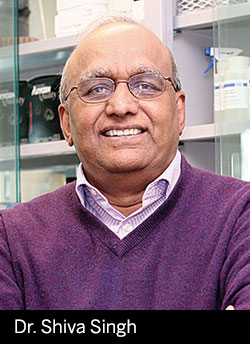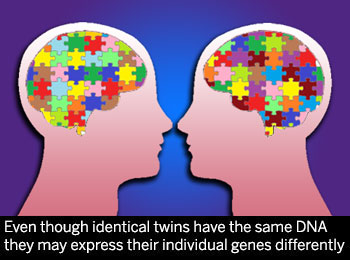Nature and nurture: identical twins and schizophrenia
 Schizophrenia is a terrifying mental illness characterized by delusions and hallucinations. While it occurs in only one percent of the population, a much larger proportion of patients belong to families where someone else has had it. Yet even within those families, most people don’t develop the disease, and the identical twin of an affected person only has a 50 percent chance of affliction – not 100 percent.
Schizophrenia is a terrifying mental illness characterized by delusions and hallucinations. While it occurs in only one percent of the population, a much larger proportion of patients belong to families where someone else has had it. Yet even within those families, most people don’t develop the disease, and the identical twin of an affected person only has a 50 percent chance of affliction – not 100 percent.
Western University’s Dr. Shiva Singh wants to know why.
The strong family pattern of schizophrenia has led researchers to believe that there is a significant role played by genes, as well as the epigenome, which turns individual genes off and on. But other factors are suspected, too, and Singh’s research supports that.
Singh is a professor in the Molecular Genetics Unit of the Department of Biology, and an Associate Scientist at the Child Health Research Institute at the London Health Sciences Centre. For 20 years, he and his team of researchers have been working with pairs of identical twins. In two pairs, one twin in each developed schizophrenia while the other did not – a remarkable opportunity to compare genetic and epigenetic mechanisms in action.
Jumping genes and epigenomes: identical twins are not identical
Since identical twins originate from the same zygote, both have the same DNA at the “macro” level known as polymorphic DNA, which will not change over the course of their lives. However, by comparing three billion bases of DNA sequences from the twins, Singh and his colleagues have established that there are significant differences at the “micro” level. These include mutations, some of which are segments nicknamed “jumping genes” for their ability to move (transpose) to a different location during cell division.
Human DNA includes fragments of ancient retroviruses, some of which have the ability to transpose, with the potential to change the way genes function. Transpositions can happen any time after fertilization and continue differently in each twin after the zygote has split.
Another major influence on gene function is the epigenome, a second set of instructions that uses proteins called epigenetic tags to activate or suppress genes. If the genome is like a piano, the epigenome is like the sheet music, with instructions for when to play (or not play) each key/gene. So while a certain combination of keys on that piano may give you curly hair, the epigenetic pages may deactivate them, giving you straight hair.
Environmental conditions like diet can influence the epigenome, just as a musician’s mood might mean the sheet music is played in a new way, making the identical twins develop differently.
The schizophrenia connection
 In Singh’s study, one pair of twins had 13 genes and the second pair had 58 genes that were different in their DNA sequence or epigenetic tags. Significantly, many of the genes that differed within each pair of twins were neuronal genes, whose job is to build and manage the nervous system. The list also included some that were previously identified as potential schizophrenia genes or their drug targets.
In Singh’s study, one pair of twins had 13 genes and the second pair had 58 genes that were different in their DNA sequence or epigenetic tags. Significantly, many of the genes that differed within each pair of twins were neuronal genes, whose job is to build and manage the nervous system. The list also included some that were previously identified as potential schizophrenia genes or their drug targets.
Another important find was that the schizophrenia-related genes identified in the list from the first pair overlapped the list from the second pair.
Singh’s research clearly supports the hypotheses that multiple genes are involved in schizophrenia, and that patients may have different – yet overlapping – genetic and/or epigenetic causes. These fascinating results narrow the field for the next steps, and Singh hopes to see a larger study of identical twins to build upon his data.
These novel results offer proof of principle that twin studies could increase the bodies of knowledge about autism, depression, bipolar disorders and other genetically linked and environmentally influenced disorders. For schizophrenia and for all of these, the greater depth of understanding could lead to more effective individualized treatments, and maybe someday, it could also lead to prevention.
Dr. Singh is a distinguished university professor at Western University. His research lab is located in the Molecular Genetics Unit of the Department of Biology in the Faculty of Science, and has been funded by NSERC, CIHR, OMHF, SSO, the Bill Jefferies Schizophrenia Endowment Fund, and the University of Western Ontario. The research discussed represents collaboration with researchers from the Departments of Biology, Psychiatry and Neuroscience, particularly Dr. Richard O'Reilly, who selected and recruited rare twins internationally for this study. Further, this research formed the focus of the Ph.D. research of Dr. Christina Castellani, who is currently a Post-Doctoral Fellow at the Johns Hopkins University, Institute of Genetic Medicine in Baltimore, MD.

